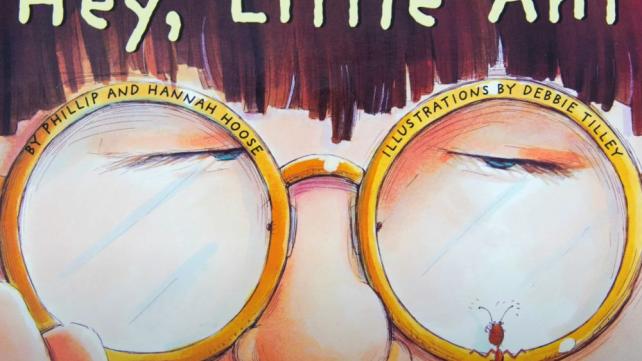
In the enchanting microcosm of Hey, Little Ant, Phillip and Hannah Hoose invite readers to tiptoe into the six-legged shoes of an insect and embark on a journey that transcends the boundaries of size, species, and perspective. Through their collaborative narrative, the father-daughter duo paints a vivid parable that doesn't merely narrate. Rather it entices readers to explore a world where compassion and empathy resonate with the hum of tiny footsteps.
This lyrical masterpiece is more than a children's book. It is an insect's-eye view into the expansive realms of the heart, where themes of empathy, responsibility, and the delicate dance of peer pressure unfurl in the breeze of a whimsical conversation between a boy and an ant. As one treads through the pages of this miniature epic, the Hooses beckon us to ponder the weight of our footsteps, urging us to see the world not just through our eyes but through the multifaceted lens of understanding and kindness.
There are timeless lessons that are put across gracefully in this book, leaving an indelible mark on young hearts and curious minds. The illustrations by Debbie Tilley are also worthy of mentioning, as they help relay the messages loud and clear. Here are some that resonated deeply within our family.
1. Consideration of other perspectives.
The story teaches children the importance of considering different perspectives. Throughout the story, the boy and the ant share their viewpoints, helping children understand that others may not necessarily share the same viewpoint as you and may see things differently.
The book explores the emotions of the ant and the boy, providing an opportunity for children to understand and express their feelings. It opens the door for discussions about empathy and emotions.
2. Empathy for all living beings.
The book encourages children to put themselves in the shoes (or six legs) of the ant, fostering empathy for creatures, no matter how small or insignificant they may seem. Children also learn about the power of compassion and respect for all beings and the impact it can have on others. The boy is faced with a decision to harm or spare the ant, and his choice will illustrate the deep-rooted value found in compassion.
3. Critical thinking and decision-making.
Towards the end (and particularly what I liked), Hey, Little Ant presents a moral dilemma to its readers, prompting children to engage in critical thinking and make ethical choices. It encourages them to think about the consequences of their actions by directing the question "What do you think that kid should do?"
The duo has also cleverly incorporated the ideology of peer pressure into the story, which in a way also allows them to take ownership of their actions. “The boy’s friends pressure him to squish the ant.”
- This acknowledges that it plays a big role in defying ethical choices.
- It allows the reader to look beyond it and learn to make more conscious decisions.
Additionally, the concept of “Power and Responsibility” is so beautifully engrained in the text as are the illustrations which magnificently highlight how “The boy has the power to squish the ant if he wants.” This is where parents can lead in on tailored discussions, such as:
- Should the boy always listen to his friends?
- Should the boy sometimes listen to his friends? If so, when?
- Do you always do what other people tell you to do?
Teaching Tolerance and Making Peaceful Choices
Ultimately, the book encourages children to make peaceful choices and find non-violent solutions to conflicts. It boldly emphasizes the importance of communication and dialogue in resolving conflicts wherein the conversation between the boy and the ant provides a model for discussing differences peacefully.
The story also advocates for resolving differences through understanding rather than aggression and teaches one to be open-minded and accepting of others, regardless of their differences.
Hey, Little Ant is a valuable resource for parents and educators, offering a child-friendly and engaging platform to impart crucial life lessons. Its narrative and illustrations prompt meaningful discussions on empathy and compassion, highlighting the interconnectedness of all living beings.
In the context of teachings from the Quran and Sunnah of our beloved Prophet, peace and blessings be upon him, the story aligns seamlessly with the emphasis on mercy, kindness, and forgiveness.
Just as the Quran emphasizes the importance of treating all creatures with compassion, the story provides a practical avenue to instill these teachings in young minds. The interconnectedness theme resonates with Islamic teachings that underscore the concept of the Ummah, emphasizing the unity of humanity. Moreover, the narrative's focus on forgiveness and understanding correlates with Quranic principles and Sunnah, encouraging individuals to admit mistakes, seek forgiveness, and foster harmonious relationships.
In using Hey, Little Ant as a tool for family discussions, parents can draw parallels with Quranic verses and Prophetic traditions that emphasize empathy, forgiveness, and recognizing the worth of every soul. This integrated approach not only enhances the educational value of the book but also aligns with the holistic teachings of Islam, fostering a foundation of compassion and understanding in the hearts of young readers.
Umm Ahmed is an early childhood educator and mother of three boys. Always on the quest to learn, she is passionate about seeking knowledge and passing it on to others. A writer in the making, she draws inspiration through deep conversations, laws of nature, and her own children. She and her family are currently living in Abu Dhabi, UAE.



Add new comment